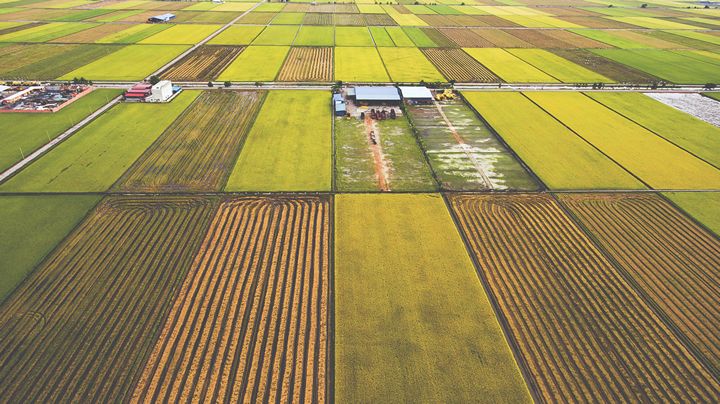Commercial satellites, equipped with a hyperspectral camera, can distinguish nearly any material on Earth and its condition through its distinct spectral signature.
 How can Earth observation drive sustainable growth and optimize agricultural yields efficiently?
How can Earth observation drive sustainable growth and optimize agricultural yields efficiently?

Jarkko Antila, CEO | Kuva Space
Modern agriculture is a balancing act between sustainability, productivity, and profitability. Farmers face growing pressure to maximize crop yields to feed a growing population while adopting more sustainable practices to ensure future field performance. However, challenges such as soil degradation, unpredictable weather conditions, tightening industry regulations, and unsustainable farming practices make it increasingly difficult to maintain productivity and, thus profitability.
Earth Observation (EO) technology offers a powerful solution to these challenges. Commercial satellites, equipped with a hyperspectral camera, can distinguish nearly any material on Earth and its condition through its distinct spectral signature. This means they can identify and monitor things like crop types, biomass growth and health both on land and in marine ecosystems, biodiversity, soil conditions, and chemical pollutants at scale.
When combined with AI, farmers can collect actionable insights to help optimize their resources, enhance yields, and improve sustainability while ensuring long-term profitability.
Monitoring soil health and crop rotation with hyperspectral imaging
Healthy soil is the foundation of long-term agricultural success. EO technology can provide continuous soil health assessments, helping farmers make informed decisions about crop rotation and soil management.
Hyperspectral imaging captures a wide range of light wavelengths beyond what the human eye can see, allowing for analysis of the topsoil composition and its changes, moisture levels, and crop conditions. With daily or even more frequent satellite data, farmers can monitor soil degradation and nutrient content in near real-time. Over time, these insights can reduce the dependence on chemical fertilizers and promote regenerative farming practices that restore soil fertility naturally.
Early detection of crop stress
Additionally, satellites equipped with advanced imaging capabilities, such as hyperspectral, can detect early signs of crop stress, nutrient deficiencies, and diseases before they become visible to the human eye. By understanding what’s happening in their fields, with automated alerts on crop health, for example, farmers can take timely action, mitigating losses and ensuring healthier crops.
Equipped with insights from the satellites, farmers can identify pest infestations or fungal infections in specific areas of their fields, allowing them to apply treatments precisely where needed, reducing unnecessary field visits, pesticide use, and costs.
Satellites that capture images of the same fields frequently, even daily, help detect these subtle changes early. This allows farmers to take action, such as adjusting irrigation or applying protective measures to minimize crop loss. Similarly, EO technology allows for the early detection of pest infestations or fungal infections, enabling precise and timely interventions that reduce unnecessary pesticide use and costs.
More accurate yield forecasting = better profitability
Accurate yield predictions are critical for financial planning and market analysis. Satellite imagery, combined with AI-driven analytics, provides near real-time insights into crop growth stages. By monitoring minor and major crops from the tillering stage onward several times a day, farmers will have access to up-to-date yield volumes and harvest timelines. Doing this earlier in the growing season allows farm cooperatives to be better positioned to negotiate prices and plan their logistics well in advance, boosting overall profitability.
Optimizing input use
EO technology helps farmers apply fertilizers, water, and pesticides more efficiently. By identifying variations in soil moisture and nutrient levels across fields, satellites can guide precision farming techniques, ensuring that resources are applied only where necessary. This not only reduces costs but also minimizes the environmental impact of excessive chemical use.
For example, precise satellite monitoring can detect specific areas in a field that require irrigation, reducing overall water usage. Similarly, it can provide alerts about localized plant diseases, allowing targeted interventions instead of blanket pesticide applications.
Additionally, seed manufacturers can compare how their seeds are performing around the world in different conditions and with different farming practices, which helps them to develop more robust seeds for the future.
Making EO technology accessible to farmers
Historically, access to high-quality satellite data has been limited by cost and complexity. However, initiatives like the EU Copernicus program and NASA’s Landsat mission have made satellite data more widely available, offering insights into crop health, soil moisture, and weather patterns. While these programs provide valuable information, their datasets often require additional processing and expertise to translate into actionable insights.
To bridge this gap, commercial EO solutions offer tailored analytics, higher-resolution imagery, and more frequent revisits, enabling farmers to make impactful, data-driven decisions. These solutions simplify satellite data interpretation, helping farmers detect early signs of crop stress, optimize resource use, and improve soil management more efficiently and cost-effectively. These advancements allow even small and mid-sized farms to benefit from EO technology without needing specialized technical knowledge.
Ensuring compliance with sustainability regulations and unlocking new revenue streams
EO technology provides verifiable data to demonstrate responsible land management, deforestation-free sourcing, and sustainable farming practices. In the U.S., farmers must adhere to regulations such as the USDA’s Conservation Compliance Program, which links federal farm payments to environmental stewardship, and the Environmental Quality Incentives Program (EQIP), which provides financial assistance for sustainable practices. Additionally, state-level initiatives, such as California’s Sustainable Groundwater Management Act (SGMA), require farmers to monitor and manage water usage efficiently.
Whereas in the EU, practices such as crop cover, zero tillage, multi-crop, natural shrubs and species are highly advocated and are increasingly getting more subsidies in an increasing number of member states.
Beyond regulatory compliance, these insights help farmers participate in carbon credit markets by verifying carbon sequestration in their soil. By adopting regenerative agriculture techniques, they can generate additional income through the sale of verified carbon credits. Sustainability certifications can also open access to premium markets, while government incentives and grants offer further financial support to environmentally responsible operations.
Conclusion
Farming insights from satellites are gradually approaching the functionality of a weather app, eventually delivering easily packaged and continuously updated insights at a highly affordable cost without the need for minimum image orders or EO expertise to be useful. Each farmer – big or small – will be able to monitor, manage, report, and automatically optimize both their farm’s performance and create new revenue streams while enforcing sustainable practices, all thanks to new EO services that are faster, more affordable, and integrated.
.jpg)
Jarkko Antila is the CEO of the Finnish hyperspectral microsatellite and AI-powered insights company Kuva Space. He has a master’s degree in space technology and a long background in deep-tech entrepreneurship, with a proven track record in product innovation and fundraising. Antila has led technology teams at VTT Technical Research Centre of Finland and Inficon. Before a successful exit, he was the co-founder and CEO of Spectral Engines, and he also has his own deep-tech business consultancy firm Leaping Boulder. You can follow him on LinkedIn.
The content & opinions in this article are the author’s and do not necessarily represent the views of AgriTechTomorrow
Comments (0)
This post does not have any comments. Be the first to leave a comment below.
Featured Product

